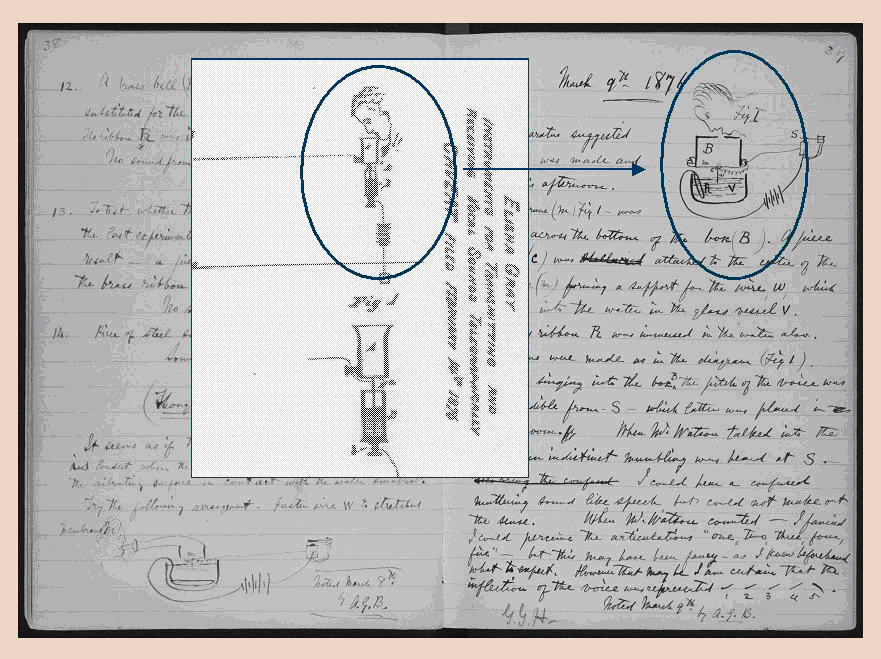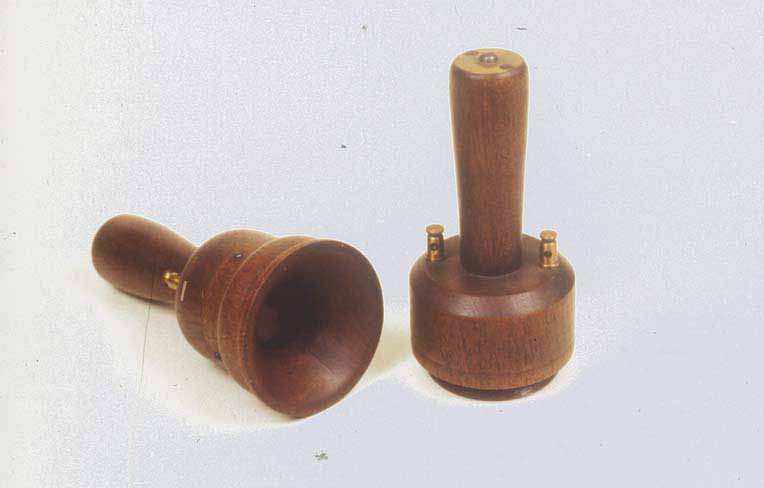|
Acoustic Telegraph
Acoustic telegraphy (also known as harmonic telegraphy) was a name for various methods of multiplexing (transmitting more than one) telegraph messages simultaneously over a single telegraph wire by using different audio frequencies or channels for each message. A telegrapher used a conventional Morse key to tap out the message in Morse code. The key pulses were transmitted as pulses of a specific audio frequency. At the receiving end a device tuned to the same frequency resonated to the pulses but not to others on the same wire. Inventors who worked on the acoustic telegraph included Charles Bourseul, Thomas Edison, Elisha Gray, and Alexander Graham Bell. Their efforts to develop acoustic telegraphy, in order to reduce the cost of telegraph service, led to the invention of the telephone.Standage, pp. 195–199 Some of Thomas Edison's devices used multiple synchronized tuning forks tuned to selected audio frequencies and which opened and closed electrical circuits at the select ... [...More Info...] [...Related Items...] OR: [Wikipedia] [Google] [Baidu] |
Multiplexing
In telecommunications and computer networking, multiplexing (sometimes contracted to muxing) is a method by which multiple analog or digital signals are combined into one signal over a shared medium. The aim is to share a scarce resource - a physical transmission medium. For example, in telecommunications, several telephone calls may be carried using one wire. Multiplexing originated in telegraphy in the 1870s, and is now widely applied in communications. In telephony, George Owen Squier is credited with the development of telephone carrier multiplexing in 1910. The multiplexed signal is transmitted over a communication channel such as a cable. The multiplexing divides the capacity of the communication channel into several logical channels, one for each message signal or data stream to be transferred. A reverse process, known as demultiplexing, extracts the original channels on the receiver end. A device that performs the multiplexing is called a multiplexer (MUX), and a dev ... [...More Info...] [...Related Items...] OR: [Wikipedia] [Google] [Baidu] |
Alexander Graham Bell
Alexander Graham Bell (, born Alexander Bell; March 3, 1847 – August 2, 1922) was a Scottish-born inventor, scientist and engineer who is credited with patenting the first practical telephone. He also co-founded the American Telephone and Telegraph Company (AT&T) in 1885. Bell's father, grandfather, and brother had all been associated with work on elocution and speech, and both his mother and wife were deaf; profoundly influencing Bell's life's work. His research on hearing and speech further led him to experiment with hearing devices which eventually culminated in Bell being awarded the first U.S. patent for the telephone, on March 7, 1876. Bell considered his invention an intrusion on his real work as a scientist and refused to have a telephone in his study. Many other inventions marked Bell's later life, including groundbreaking work in optical telecommunications, hydrofoils, and aeronautics. Bell also had a strong influence on the National Geographic Society and its ... [...More Info...] [...Related Items...] OR: [Wikipedia] [Google] [Baidu] |
Berkley Books
Berkley Books is an imprint of the Penguin Group. History Berkley Books began as an independent company in 1955. It was founded as "Chic News Company" by Charles Byrne and Frederick Klein, who had worked for Avon; they quickly renamed it Berkley Publishing Co. The new name was a combination of the their surnames, unrelated to either the philosopher George Berkeley or Berkeley, California. Under their editor-in-chief Thomas Dardis, over the next few years Berkley developed a diverse line of popular fiction and non-fiction, both reprints and mass-market paperback originals, with a particularly strong history in science fiction (books of Robert A. Heinlein and Frank Herbert’s '' Dune'' novels, for example). The company was bought in 1965 by G. P. Putnam's Sons and in years to follow undertook a hardcover line under the Berkley imprint, chiefly but not only for science fiction. For example, Merle Miller’s ''Plain Speaking: An Oral Biography of Harry S. Truman'' (1973), and '' ... [...More Info...] [...Related Items...] OR: [Wikipedia] [Google] [Baidu] |
Invention Of The Telephone
The invention of the telephone was the culmination of work done by more than one individual, and led to an array of lawsuits relating to the patent claims of several individuals and numerous companies. Early development The concept of the telephone dates back to the string telephone or lover's telephone that has been known for centuries, comprising two diaphragms connected by a taut string or wire. Sound waves are carried as mechanical vibrations along the string or wire from one diaphragm to the other. The classic example is the tin can telephone, a children's toy made by connecting the two ends of a string to the bottoms of two metal cans, paper cups or similar items. The essential idea of this toy was that a diaphragm can collect voice sounds from the voice sounds for reproduction at a distance. One precursor to the development of the electromagnetic telephone originated in 1833 when Carl Friedrich Gauss and Wilhelm Eduard Weber invented an electromagnetic device for t ... [...More Info...] [...Related Items...] OR: [Wikipedia] [Google] [Baidu] |
Telegraph
Telegraphy is the long-distance transmission of messages where the sender uses symbolic codes, known to the recipient, rather than a physical exchange of an object bearing the message. Thus flag semaphore is a method of telegraphy, whereas pigeon post is not. Ancient signalling systems, although sometimes quite extensive and sophisticated as in China, were generally not capable of transmitting arbitrary text messages. Possible messages were fixed and predetermined and such systems are thus not true telegraphs. The earliest true telegraph put into widespread use was the optical telegraph of Claude Chappe, invented in the late 18th century. The system was used extensively in France, and European nations occupied by France, during the Napoleonic era. The electric telegraph started to replace the optical telegraph in the mid-19th century. It was first taken up in Britain in the form of the Cooke and Wheatstone telegraph, initially used mostly as an aid to railway signalling. Th ... [...More Info...] [...Related Items...] OR: [Wikipedia] [Google] [Baidu] |


